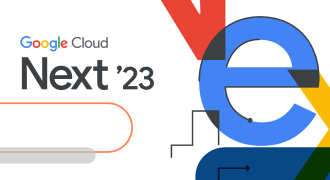
Blog
TelcoDR’s Watch List for Google Cloud Next ’23
Google Cloud Next runs from August 29-31. Check out my hand-picked shortlist of must-see topics for telcos.
Google Cloud and Microsoft Azure, two of the Big Three hyperscalers, went head-to-head with their annual events a couple weeks ago. As they kicked off, I offered my take on which sessions were most relevant to telco. Now, I’m circling back through all the big announcements dropped by both companies to highlight the ones communication service providers will care about the most.
And don’t forget—the third and biggest hyperscaler, Amazon Web Services (AWS), hosts its re:Invent shindig at the end of next month in Las Vegas, so keep an eye out here for my prequel and sequel analyses.
If you missed the event, you can catch up with this super helpful 13-minute recap of the highlights. Here are the most notable nuggets.
The biggest telco headline to come out of Google Cloud Next is that T-Mobile has finally signed with a hyperscaler: Google Cloud. The partnership’s initial focus will be improving customer experiences with data analytics, artificial intelligence (AI), and machine learning (ML). The teams will put T-Mobile’s subscriber data to work to learn more about customers, predict usage trends, understand customer sentiment, and find new business opportunities. T-Mobile is probably jealous of everything Vodafone’s been doing through its partnership with Google Cloud—as every telco should be! You know I’m a big advocate for using the public cloud to enhance and personalize the subscriber experience; it’s part of my vision for my company, Totogi. I’m definitely looking forward to seeing what T-Mobile and Google Cloud achieve.
Migrating to Google Cloud just got easier. Dual Run is a new service that’ll help you move your mainframes to the public cloud. The press release says banks, retail, and healthcare have mainframes, but I know telco STILL has them, too. It’s okay. Admitting you have a problem is the first step. Now, there’s help. The Migration Center is designed to help you assess and plan your move, and Database Migration Service helps with the actual migration. I love how hyperscalers are dipping down into reality to help telcos move data and workloads to the public cloud.
Back to what Vodafone and Google are doing with the telco’s subscriber data—creating a single source of truth for the entire organization that can reduce costs, streamline operations, and bring new offerings to customers worldwide. You get why this is a big deal. Telcos are sitting on a goldmine of data that could improve customer service, identify new lines of business, and even tailor plans to individual subscribers. Google’s open data cloud ecosystem helps you to aggregate and understand all your data from all sources in all storage formats from all cloud providers, so you can put it to work, apply AI and ML, make it more accessible, and get more insight from it. This is a huge benefit of moving to the public cloud, and the available tools keep getting better.
Google Cloud is in a building frenzy! Already at 35 regions, with five opened this year and four more announced, it added another five to the list: Austria, Greece, Norway, South Africa, and Sweden. If not having a data center near you is keeping you from the public cloud, just wait a minute. There will be one (or more) in your backyard soon enough.
Microsoft didn’t have much Ignite content specifically for the telco industry, but there’s still plenty of good telco news that came out of the event.
After launching Azure public MEC in preview last year, Microsoft made it generally available during Ignite. (The company’s Azure private MEC launched last year.) This solution enables enterprises and developers to deliver high-performance, low-latency applications and experiences using operators’ public 5G networks. It’ll be available next month in Atlanta and Dallas, and “soon” in Detroit and NYC.
Watch out, Oracle. There’s a new database migration tool in town. Like Google Cloud and AWS, Azure is paving the way for you to leave your on-prem data center behind. The Database Migration Assessment for Oracle is an Azure Data Studio extension powered by Azure Database Migration Service that helps with the move from Oracle Database to Azure Database for PostgreSQL. It’s in preview only right now, but should help Oracle customers cut costs and maintain performance. (If Amazon can get off Oracle, you can too!)
As Mark Zuckerberg announced at Meta Connect (also this week), the metaverse has legs (pun intended)—especially in the enterprise space. At Ignite, Microsoft echoed this sentiment in several ways. A 20-minute session called The Industrial Metaverse promoted the idea that there are three metaverses: consumer, commercial, and industrial.
All that said, the metaverse—whatever form it ends up taking—is a very exciting opportunity for telco because there’s no way any of it can work without your network. I’m not saying telcos need to solve the metaverse problem and build all their apps, but I think they should make their networks super open to it—and figure out how to monetize it (maybe charge by the API call, like DISH plans to do).
Honestly? I’m ready. If I could create an awesome, virtual-reality me, and be in India and Australia simultaneously, and skip a bunch of business travel, SIGN. ME. UP. (P.S. I would make my avatar super-hot. Maybe like Trinity from the Matrix; that was her avatar, too.)
That’s a wrap on this year’s Google Cloud Next and Microsoft Ignite. Don’t forget to watch this space for a preview and wrap up of AWS re:Invent, running November 28 – December 2, 2022.
Recent Posts

 Get my FREE insider newsletter, delivered every two weeks, with curated content to help telco execs across the globe move to the public cloud.
Get my FREE insider newsletter, delivered every two weeks, with curated content to help telco execs across the globe move to the public cloud.